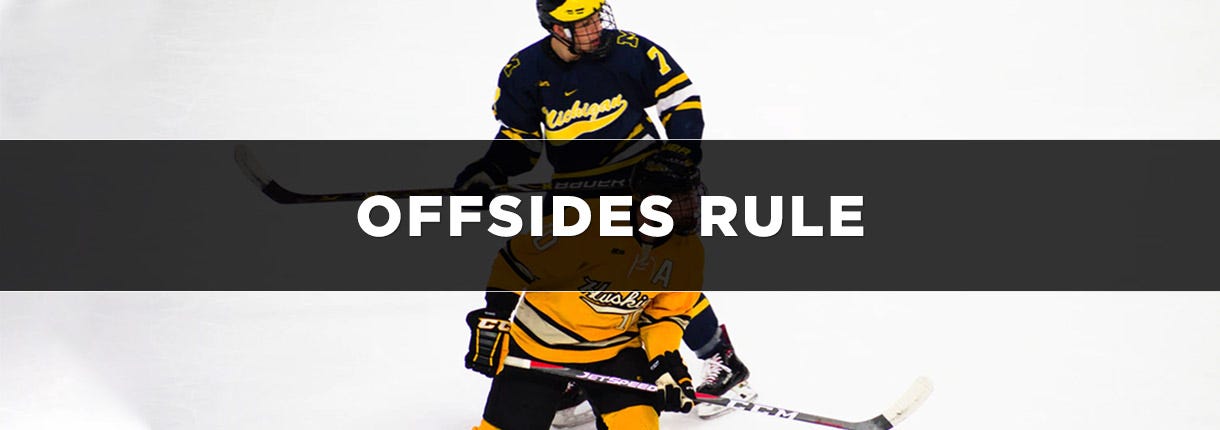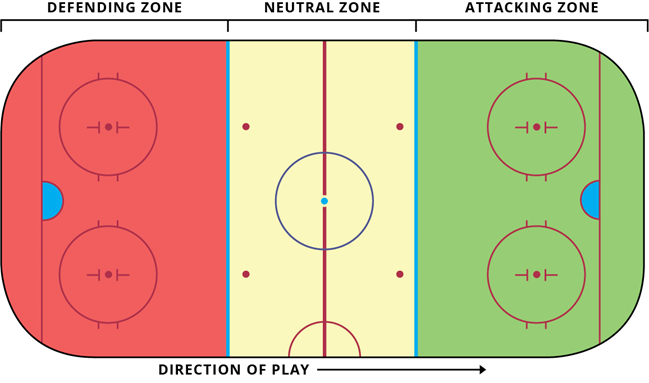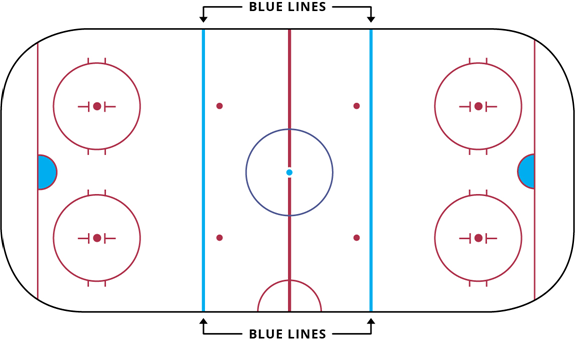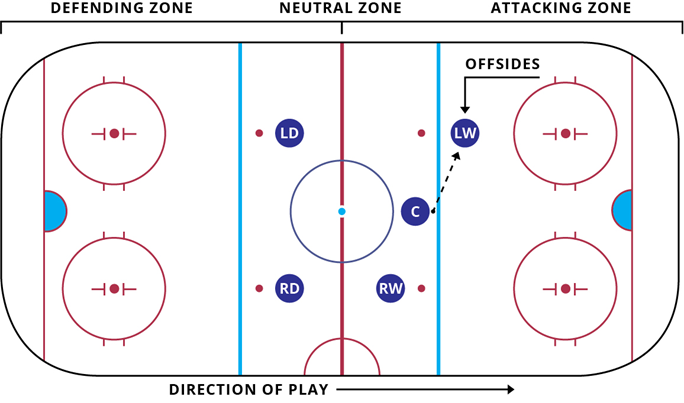What is Offsides in Hockey? Learn Hockey’s Offsides Rule

Offsides is one of the key components to an ice hockey game and can be a make or break factor when determining the outcome of a scoring play. It wasn’t until 1928 that players were allowed to move the puck in any direction, meaning players were standing in front of opposing goaltenders, receiving full-ice passes and then taking uncontested shots on the goaltender. Shortly thereafter, in 1929, the modern offsides rule was introduced.
For new viewers, the game of ice hockey can be overwhelming at first and this article will aim to break down one of the game’s most important rules: offsides. You can expect to learn what the rule of offsides is, what it looks like, what zones are on a hockey rink and how they are separated, along with the different types of offsides, and what happens when an offsides call is made by the referee. For new and experienced players, shop our full inventory of hockey equipment to get ready for your next game today!
- What is Offsides in Hockey?
- The 3 Zones of a Hockey Rink
- What is the Blue Line in Hockey?
- Illustration: What Offsides in Hockey Looks Like
- Types of Offsides in Hockey
- What Happens When Offsides is Called?
What is Offsides in Hockey?
Offsides in hockey is when both of a player’s hockey skates completely cross the attacking-zone blue line before the puck completely crosses that same blue line. This means that if a player attacking the offensive zone keeps one of his hockey skates on, or behind, the blue line, the play continues. Furthermore, the position of the players’ hockey skates is the determining factor of whether a player is offsides or not, meaning the position of the players’ hockey stick has no bearing on the play. This is why you will see players often drag their back skate, or completely stop, when their team is carrying the puck into the offensive zone.
Players are allowed to skate into the offensive zones whenever they want, so long as they do not touch the puck while still inside the zone, whether receiving a pass or collecting a puck clearance. A puck clearance is when a player from the attacking team dumps the puck into the offensive zone in order to get new players onto the ice.
If offsides is called by the referee, the play stops, and a faceoff will take place in the neutral zone on the side that the infraction occurred.
The 3 Zones of a Hockey Rink
Ice Hockey Rinks are divided into three sections, separated by two horizontal blue lines. Below you will find an image of these zones with their respective names and the purpose of each one.

Defensive Zone
The Defensive Zone will have each team’s own goal and will be the area where they attempt to stop the opposing team from scoring. These zones will feature two faceoff circles, one to the left and right sides of the goaltender.
Neutral Zone
The middle portion of the ice hockey rink, separated by the two horizontal blue lines, is called the neutral zone. This is typically referred to as center ice. This zone has one faceoff circle and is typically used for faceoffs during icing calls as well as the faceoffs for the start of the game and each period.
Attacking Zone
The Attacking Zone, or Offensive Zone, is the zone in which the team with the puck is trying to score on the opposing team’s goaltender. The attacking zone features two faceoff circles as well.
What is the Blue Line in Hockey?
The blue line in ice hockey is what divides the hockey rink into three zones: the defensive zone, the neutral zone, and the attacking zone. The blue lines also determine whether or not a player is offsides. If an attacking player crosses the blue line into the attacking zone before the puck and touches it, the referee will call offsides and stop the play.

Illustration: What Offsides in Hockey Looks Like
Below is a diagram of what offsides looks like during an ice hockey game. The puck carrying team is advancing the puck, via the centerman, into the attacking zone (the opposing team’s defensive zone). The centerman makes a pass to the left winger, but the left winger is already completely across the attacking blue line. If the left winger touches the puck here, the play will immediately be stopped for an offsides call. If the left winger is already across the blue line and a pass comes to him, but he does not touch the puck, it will be what is called a delayed offsides, which can be read about below.

Types of Offsides in Hockey
There are three types of offsides in ice hockey, each one with differing outcomes. They are delayed offsides, intentional offsides, and offsides deflections.
Delayed Offsides
Delayed offsides is called when a player of the attacking team is already within the offensive zone before the puck is but has not been touched by him or a member of his team. In almost all leagues, the attacking team can “tag up,” meaning all members have a chance to exit the offensive zone. Tagging up means all attacking players can come back and skate across the blue line back into the neutral zone, then reenter the offensive zone again in the attempt to get the puck back. Once all offensive players exit the attacking zone, the delayed offsides call is then nullified. If a player from the attacking team touches the puck during their “tag up” process while the puck is still in the offensive zone, it will immediately be called offsides.
Intentional Offsides
Intentional offsides is called when the referee deems that the attacking team intentionally tried to have an offsides called on them. It happens when the puck carrier shoots the puck into the offensive zone and one of his teammates touches the puck while he is in said zone. This is usually done in the attempt for a team to get a line change when their current players are tired but cannot get off the ice.
Offsides Deflections
Offsides Deflections, while a rare occurrence, can still be deemed offsides by the referee. An example of this would be if the defending team tries to clear the puck and it hits an official in the neutral zone and goes back into the defensive zone, it can still be considered offsides. In this same instance, if the puck leaves the zone and deflects off a defending player and back into their zone, it will be deemed not offsides and the attacking team has the opportunity to continue playing the puck.
What Happens When Offsides is Called?
If a member of the team with the puck crosses over the blue line into the offensive zone before the puck does and plays it, the referee will make an offsides call. This consists of the referee blowing his whistle and stopping the play immediately. Right after blowing his whistle he will yell “offsides,” letting players know why the game has been halted. During this, he will point to where the infraction took place via a chopping motion with his hand. Following the stoppage of play, the puck will be taken into the neutral zone for a faceoff. The faceoff will take place on the same side of the ice that the infraction occurred.
Face-Off Locations for Offsides
Whichever side the infraction took place on is where the faceoff would be, in the neutral zone. For example, if a team is skating the puck up the ice and an offensive player enters the attacking zone before the puck, on the left side of the ice, the referee will stop gameplay. The faceoff would then take place on the left side faceoff dot in the neutral zone, closest to the attacking zone. However, if the referee determines a play to be an intentional offsides, the faceoff would then take place in the offending team’s defensive zone, on the corresponding side the infraction took place.











